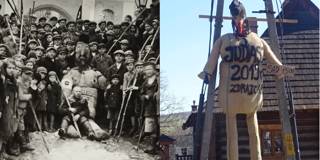Throughout Poland’s history as an independent nation-state, the myth of “Judeo-communism” has served many purposes, from justifying anti-Semitic pogroms and cracking down on dissent to carving out political constituencies in the modern era. Precisely because the trope has no bearing on truth, it remains malleable in the hands of cynics and demagogues.
WARSAW – On Good Friday this year, residents of Pruchnik (population 3,519), a town in southeast Poland, carried out the ritual beating, hanging, dismembering, burning, and drowning of Judas in effigy. The ceremony included children, who were furnished with sticks and encouraged to beat a dummy with the peyos (“side curls”) and head covering of a Hasidic Jew. The effigy also had a giant red nose, a common adornment in Polish depictions of Judas that is meant to equate Jews with communists.
The Pruchnik ritual is not a unique occurrence. In March, a Polish right-wing newspaper featured the front-page headline: “How to Spot a Jew.” When Georgette Mosbacher, the US ambassador to Poland, offered her official Passover wishes in April, she was flooded with hateful responses on Twitter and elsewhere. Then, on April 30, someone in Łódź hanged an effigy of the Jewish communist leader Jakub Berman from a gallows adorned with a swastika. It was all reminiscent of an episode in 2015, when someone burned an effigy of a Hasidic Jew in Wrocław’s central market, claiming later that it was meant to represent the financier and philanthropist George Soros.
Pruchnik observed this Christian Good Friday tradition of dragging, beating, and dismembering Judas even under Nazi occupation during World War II. Photographs from that period show children, armed with sticks, surrounding a gigantic doll with a German-introduced Star of David armband. The event is thoroughly scripted, and just before the effigy is burned and drowned in the river, its head is cut off and saved for use the following year. In contemporary footage of the event, the atmosphere is festive: all of the children are excited; and when the burning Judas is thrown into the river, one can hear an older woman lamenting that the water level of the river is not as high as it once was.

WARSAW – On Good Friday this year, residents of Pruchnik (population 3,519), a town in southeast Poland, carried out the ritual beating, hanging, dismembering, burning, and drowning of Judas in effigy. The ceremony included children, who were furnished with sticks and encouraged to beat a dummy with the peyos (“side curls”) and head covering of a Hasidic Jew. The effigy also had a giant red nose, a common adornment in Polish depictions of Judas that is meant to equate Jews with communists.
The Pruchnik ritual is not a unique occurrence. In March, a Polish right-wing newspaper featured the front-page headline: “How to Spot a Jew.” When Georgette Mosbacher, the US ambassador to Poland, offered her official Passover wishes in April, she was flooded with hateful responses on Twitter and elsewhere. Then, on April 30, someone in Łódź hanged an effigy of the Jewish communist leader Jakub Berman from a gallows adorned with a swastika. It was all reminiscent of an episode in 2015, when someone burned an effigy of a Hasidic Jew in Wrocław’s central market, claiming later that it was meant to represent the financier and philanthropist George Soros.
Pruchnik observed this Christian Good Friday tradition of dragging, beating, and dismembering Judas even under Nazi occupation during World War II. Photographs from that period show children, armed with sticks, surrounding a gigantic doll with a German-introduced Star of David armband. The event is thoroughly scripted, and just before the effigy is burned and drowned in the river, its head is cut off and saved for use the following year. In contemporary footage of the event, the atmosphere is festive: all of the children are excited; and when the burning Judas is thrown into the river, one can hear an older woman lamenting that the water level of the river is not as high as it once was.